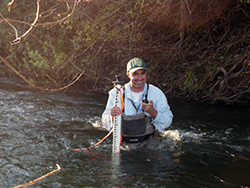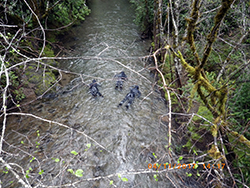Robert Holmes is an Environmental Program Manager supervisor over the Statewide Water Planning Program in CDFW’s Water Branch. Robert leads efforts in the statewide implementation of the Instream Flow Program, sustainable groundwater management, and water rights activities.

Robert conducts a topographical survey of pool habitat on Big Sur River.

Robert and crew snorkel-survey Coho salmon and steelhead habitat use on South Fork Eel River tributary.
Robert Holmes is an Environmental Program Manager supervisor over the Statewide Water Planning Program in CDFW’s Water Branch. Robert leads efforts in the statewide implementation of the Instream Flow Program, sustainable groundwater management, and water rights activities.
Robert has been with the Water Branch for 10 years, and has worked on instream flow, water quality, and aquatic species and habitat assessments for over 20 years for the State of California. Robert is a freshwater biologist and received a Bachelor of Science from CSU Sacramento in Conservation Biology, and a Master of Science from Humboldt State in Natural Resources where his thesis work was on steelhead trout early life history development.
What inspired you to become a scientist?
I spent my childhood playing outdoors and learned a great appreciation for nature early on – exploring catching and identifying frogs, spiders, turtles, snakes and other critters. Basically, science has always been that pathway of learning about the outdoor world for me. I had lots of questions. What kind of spider is that? What kind of bird? What does it eat? Why is it only here in winter? Fast-forward to today and I’m still asking questions about the natural world, when I’m chasing fish to document habitat use and availability, collecting streamflow to determine gains and losses in a stream reach, or evaluating physical habitat suitability data. There are many rivers and places to explore, many questions to answer about the natural world, and much to learn!
What got you interested in working with water - and fish and wildlife?
Recreation! Growing up near the lower American River, I spent a lot time there with friends, riding bikes, swimming, skim boarding and fishing. In high school we would go snowboarding near Castle Peak, and later, whitewater kayaking and wakeboarding local rivers. On several occasions, when spring conditions were right, we would follow the westward flow of water from the summit to valley by hiking and snowboarding the backcountry of Donner Summit, kayaking a class IV stretch of one of the forks of American River, and then wakeboarding the lower Sacramento River. And that’s all in one weekend! I also like to fly fish. There’s nothing like those cold crisp winter mornings when fishing and it’s so cold your line freezes to the rod and you can barely feel your fingers. It’s worth it when you get the tug on your line, or a steelhead does a tail dance across the top of the water after taking your fly, and you pull them in and see that color! Drifting the Feather River or Yuba River for steelhead is fun, but trout fishing the Eastern Sierra is my favorite.
What brought you to CDFW? What inspires you to stay?
I was awarded a grant in graduate school at Humboldt State funded by the CDFW to develop a spawning and stocking program for coastal cutthroat trout in Humboldt County. At the time, I was also the assistant manager of the HSU Fish Hatchery. I formally came to the CDFW Water Branch in 2008 as the Statewide Instream Flow Coordinator. What inspires me and keeps me here is knowing how important the work is we do in developing instream flow criteria and recommendations for the protection and conservation of our fish and wildlife and their habitats. Our work is a critically important piece of information used by decision makers when balancing water needs and demands and determining water allocation schedules. We also have an awesome professional team who shares a solid work ethic, commitment, and passion for their work and meeting the CDFW mission!
What is a typical day like for you at work?
There is no typical day – really! Every instream flow study we work on and every associated river we step our boots in the water is different and presents its own unique challenges. One thing is for sure – there always needs to be a Plan A, and Plan B, and even a Plan C. Doing field studies brings lots of challenges. We have to plan our activities around storm events, rising and receding flow levels, droughts, access agreements, travel times, species periodicities, equipment limitations and so on. At the end of the day, the priority is always crew safety. We have had to call off several scheduled field days due to potentially unsafe conditions for our field crews presented by heavy storms and high streamflows.
What is special about working in instream flow?
Effective riverine resource stewardship and management is generally achieved by integrating science, policy and public involvement. We conduct instream flow studies to determine instream flow needs for fish and wildlife protection. These studies must be technically defensible, consistent with policies and coordinated and vetted in a transparent process. Therefore, success at achieving flow levels for the protection of fish and wildlife and their habitats is heavily reliant on this three-way interaction between the science, policy and public involvement.
What is special about the field of instream flow is that it takes a diverse, technically trained crew to do our job. For example, we have to draw upon all our scientific disciplines to get the job done – biologists, ecologists, hydrologists, water management scientists, engineering geologists, hydraulic engineers and others. I also get the privilege of working on external projects with some of the best and most well respected scientists in the field of instream flows, aquatic ecology and fisheries. Currently we are participating in an effort with hydrologists from UC Davis and other scientists to develop a statewide framework for assessing ecosystem and environmental flow criteria. This effort is really exciting as it has the potential to be very useful for several of our CDFW headquarters and regional program functions that use instream flow criteria for doing their jobs.
What is most challenging aspect of your job?
A commonly heard complaint of instream flow is that it is an issue of “water for fish versus people” and that instream flow practitioners advocate natural conditions in rivers at the expense of other water users. This idea is popular, but misleading, because all water uses – for recreation, for municipal supply, for industry, for fish and wildlife – are ultimately for the benefit and enjoyment of people in one way or another. In the long run, reserving water for instream flow is about the use and enjoyment of the river’s natural resources by future generations. Since these future users of water are not available to express their needs or desires, fish are often used as an indicator of healthy river conditions. So preserving instream flows (and fish) today actually preserves water management options for future generations.
What is the most rewarding project that you’ve worked on for CDFW?
Every project is rewarding in different ways. Probably most rewarding from a big picture view is knowing how important the work we do is in the decision making and balancing processes by the State Water Board. It was actually very rewarding to publish a recent study of steelhead habitat selection and availability from the Big Sur River, which was initially approved for publication in North American Journal of Fisheries Management, in our very own Fish and Game Journal’s 100th year  “Special Fisheries Issue” (PDF). There was only one chance to publish in this special issue – the next one is another century away! Our team has published multiple papers in several of the top scientific international peer review journals – but being a part of the 100th year of publication special fisheries issue was cool!
“Special Fisheries Issue” (PDF). There was only one chance to publish in this special issue – the next one is another century away! Our team has published multiple papers in several of the top scientific international peer review journals – but being a part of the 100th year of publication special fisheries issue was cool!
If you had free reign and unlimited funding, what scientific project would you most like to do?
Understanding the relationship between surface water and groundwater on streams and rivers is really important as it has the potential to affect both the quantity and quality fish and wildlife habitats. Generally speaking, surface water and groundwater systems are connected in most landscapes and streams interact with groundwater in three basic ways: streams gain water from inflow of groundwater through the streambed, streams lose water by outflow through the streambed, or they do both depending upon the location along the stream. Groundwater seepage is vitally important to the hydrologic cycles and for fish and wildlife in California because it is responsible for keeping water in rivers during times of no rainfall (i.e., base flow conditions). I would really like to see more research into understanding these surface water and groundwater relationships on a regional and statewide scale and how this interaction can affect the base flows for fish and wildlife.
What is the best thing about being a fish and wildlife scientist?
The best thing about being a scientist is turning field data into information for decision making processes. Putting on a cold (and still wet) wetsuit in the morning and hopping into ice cold frigid water to survey salmonid habitat use would not be considered fun by many. But the best part is actually being in the water with the fish and observing and recording their behavior in their habitat – specifically observing the microhabitats they select to occupy (or not) and feed or hold, and how they interact among themselves and with other species as they grow and compete for resources – and as flow levels change. After collecting data it is the scientists’ responsibility of turning that observation data into information that natural resource managers, the public, and decision makers can use. Honestly, seeing this whole scientific process through – identifying study questions, study design and planning, implementation and then reporting – is the best part of being a fish and wildlife scientist!
Do you have any advice for people considering careers in science or natural resources?
Get your feet wet! Do internships while in college and try different jobs in the field of your interest. First, you will be able to figure out what is right for you, and maybe what is not. Second, these jobs, whether volunteer or paid, and the associated people you meet and interact with early in your education and career will likely be important as you develop professional relationships and move into a career down the road. And most of all – have fun! Science is important, challenging, rewarding and fun.
CDFW photos. Top photo: Robert conducting snorkel survey of steelhead habitat use on Big Sur River.